Positive reinforcement training is a dog training method that focuses on rewarding good behavior rather than punishing bad behavior.
An increasingly popular training method, positive reinforcement training is also referred to as R+ or force-free training, since it avoids the aversive methods that are common to some other approaches.
We’ll explain why positive reinforcement training has become the training method of choice and outline the basics of the approach below!
What is Positive Reinforcement Training?
Positive reinforcement training is all about reinforcing desired behavior through rewards.
Did you ever have a teacher growing up who gave you a piece of candy for answering a question correctly? This is a great example of positive reinforcement!
You’ll need to figure out a reward that will appeal to your pooch. Most likely, the best reward will be noms!
Common Rewards for R+ Dog Training
Nearly all dogs are heavily motivated by food or high-value training treats, but goodies don’t have to be the only way we reward dogs for desired behaviors.
Other rewards we can offer our dogs include:
- Praise
- Toys
- Games (like a game of fetch)
- Anything an individual dog finds rewarding
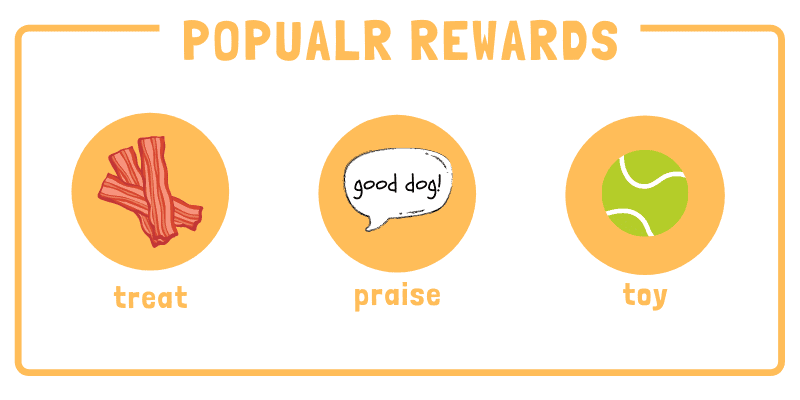
Food is undoubtedly the most powerful motivator for most dogs (especially stinky meat treats), but other rewards can work well too. Think about your dog as an individual and identify what they find particularly rewarding.
Can You Just Use Praise to Train Your Dog?
Many owners aspire to have their dogs perform desired behaviors for praise only. After all, shouldn’t your dog want to please you all the time? This expectation comes as a result of unhealthy mythologizing around dogs.
Dogs are animals who do what works for them.
They may love you very much, but they will perform behaviors that are in their best interest. Food is simply the most powerful motivator for the vast majority of dogs.
It’s also important to put yourself in the mind of a dog. As owners, we may assume that a pat on the head or a hug is a wonderful form of affection.
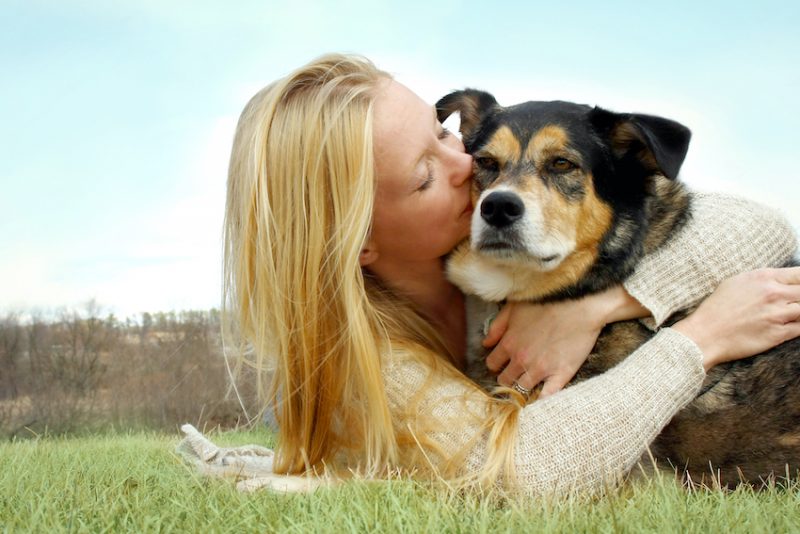
But in reality, most dogs don’t enjoy being patted on the head — they’d much prefer a chin or butt scratch. And the majority of dogs absolutely detest hugs, merely tolerating them for our sake.
Instead of focusing on what you think should be a good reward for your dog, consider what actually will motivate your pooch in reality.
Examples of Positive Reinforcement Training for Common Canine Issues
Let’s look at some examples of how positive reinforcement is used when dealing with undesired behaviors.
Problem: Your dog jumps up on you when you come home.
Using positive reinforcement, you wouldn’t knee your dog in the waist (a popular old-school training technique) or shock them with a collar. Instead, you’d simply avoid reinforcing the unwanted behavior by ignoring them. No attention, no recognition, nothing. Once they have all four paws on the ground, you would reinforce the desired behavior (paws on the ground) with praise, attention, and treats.
Problem: Your dog barks at the mailman when he drops off a package at the door.
Using positive reinforcement, you wouldn’t mess around with a bark collar or yell at your dog to be quiet. Instead, you would reward your dog the second he stops barking, even if it’s just to take a deep breath or because you walked over to him.
You would continue to simply wait for the moment your dog pauses his barking and reward him for that moment of silence. Continue to reward your dog for silence, even if it is momentary and followed by more barking. As your dog learns that he is getting treats only when he stops barking, he will begin to choose to look at you instead of barking up a storm when he sees the mailman. Soon the mailman himself will be associated with tasty treats!
The Importance of Timing
Timing is extremely important for positive reinforcement training. For this method to work, you must reward your dog immediately after he performs the desired behavior.
Let’s say you’re teaching your dog to sit.
He performs the sit as desired, so you go to grab him a treat. As you return and give your dog the treat, he’s stood up. Now you’ve rewarded the standing – not the sitting!
Because timing is so important, positive reinforcement usually necessitates the use of a convenient treat pouch . Many trainers also implement a training clicker, which can be used to be more exact with timing.
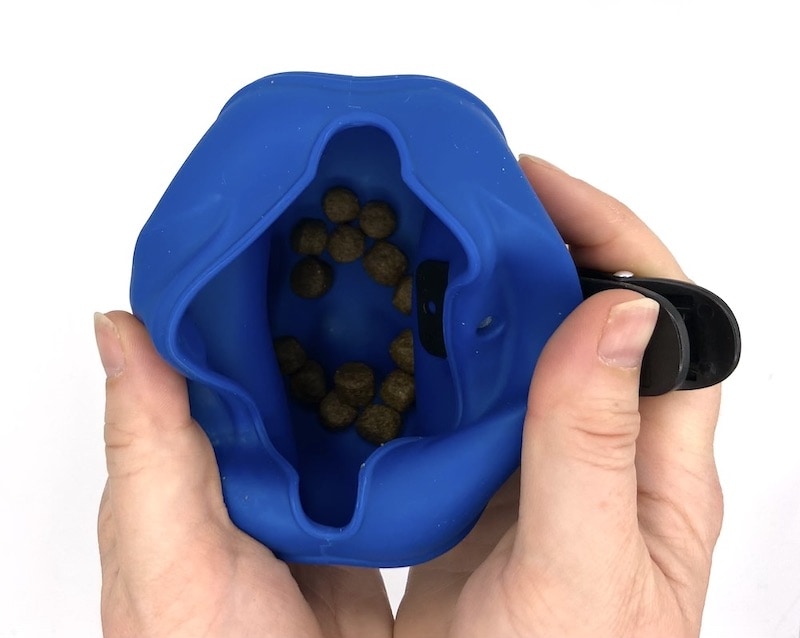
What Are the Benefits and Drawbacks of Positive Reinforcement Training?
Positive reinforcement-based training offers some significant benefits, including:
- More trust between you and your dog
- A deeper, richer bond
- Better communication and understanding of one another
- Building a positive association around humans in general
- It’s safe for kids to engage in
Positive reinforcement training only has one significant drawback: It requires a lot of patience.
The truth is that positive reinforcement can take some time to bear fruit when combating problem behaviors. This is because the owner must wait until their dog makes the correct choice, and must reinforce these good choices many times for it to become engrained.
A great example? Teaching your dog not to bark at guests.
Image a scenario where you invite a guest into your home and your dog starts barking at her.
With positive reinforcement training, you will simply let your dog bark while you ignore the behavior. As soon as he stops barking – even just for a second – you’ll reinforce his silence with a treat.
You can see this is where a clicker comes in handy as a great aid for positive reinforcement training.
In some cases, you are trying to reinforce a very brief moment of good behavior, and a clicker can be a huge aid in a scenario like this (don’t worry, we’ll talk more about the pros and cons of clickers below).
You would continue to reward your dog for being quiet in the presence of the stranger. The first few times a visitor comes over, you’ll likely need to reward him for even a split-second of silence.
But, as training goes on, you’ll up the ante and only reward him for every 3 seconds of silence.
Then you’ll want to wait for 5 seconds, then 10 seconds, and so on. Until eventually, your dog has no interest in barking at strangers because he knows now that he’ll get rewarded for silence.
What Treats Are Best For Positive Reinforcement Training?
Positive reinforcement requires that you share high-value rewards with your pooch — that’s how you keep him motivated.
Some dogs will be motivated by kibble when working on basic commands, but more challenging tricks and behavior modification requires tastier treats!
How many kids are motivated more by Fig Newtons over Oreos? Probably not too many…
The best treats for training are usually:
- Stinky (usually meat-based odors work best)
- Small (you’ll be using a lot of treats in a training session, so the smaller is better)
- Soft (crunchy treats take too long for your dog to eat)
- Novel (new treats are always more exciting to dogs than a treat they already receive regularly)
See some of the best high-value training treats for dogs!
When Can I Stop Giving My Dog Treats?
Initially, you’ll want to reward your dog each and every time he performs the desired behavior.
Once your dog has a firm grasp on the behavior you want, you can begin to dispense treats intermittently, but always reward with praise.
You can start tapering down by rewarding with treats three out of four times, two out of four times, and so on. However, you’ll never want to stop rewarding with treats permanently.
Treats should continue to be used intermittently for rewarding even long-established behavior for further reinforcement.
Wait – you mean I ALWAYS have to give my dog treats?
Yes and no.
You will always need treats to reinforce a good behavior, but as your dog gets better at performing the desired behavior, treats can become less frequent.
The idea is that eventually, with a lot of repetition, the desired behavior (for example, your dog not barking at strangers) will become the default behavior he simply performs out of habit.
However, you’ll always need to give him treats periodically. You should do this even with a dog who hasn’t barked at a guest in weeks!
Trainers like to use the comparison of treat dispensing to getting paid. How long would you keep working at your job without getting paid?
Don’t expect your dog to continue to work for you unless he is paid adequately too!
Once a behavior is well established, you can also begin to go lower on the hierarchy of rewards. Instead of using stinky freeze-dried liver, you might use kibble.
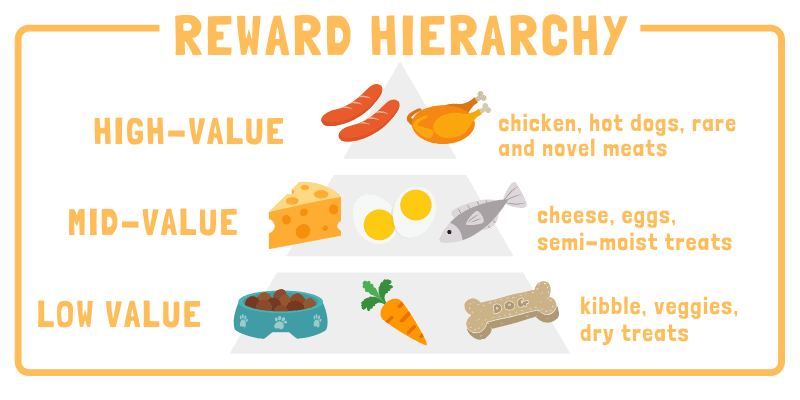
However, make sure not to reduce reinforcement too quickly while simultaneously lowering the value of the reward. Doing both at once can make your dog backtrack, damaging all your hard work!
If you’re wondering when you can stop giving treats entirely, the answer is NEVER!
You will always need to continue to reinforce good behavior, even if the frequency required is less.
Motivating Your Dog: You’ll Always Need To Choose Between the Carrot and the Stick
Detractors of positive reinforcement like to label R+ trainers as “cookie pushers.”
It’s true that treats are a huge part of positive reinforcement training, but they don’t have to be the only form or reinforcement you provide. Some dogs will consider a quick game of fetch or tug as a fantastic reward!
However, for most owners, treats are the easiest option. While your dog may love praise, it’s not usually quite enough incentive for most doggos.
Here’s what many folks don’t seem to understand about dogs: Something will always be driving your dog’s behavior.
No one on this wide green earth does anything for nothing, and you will have to choose between the carrot and the stick.
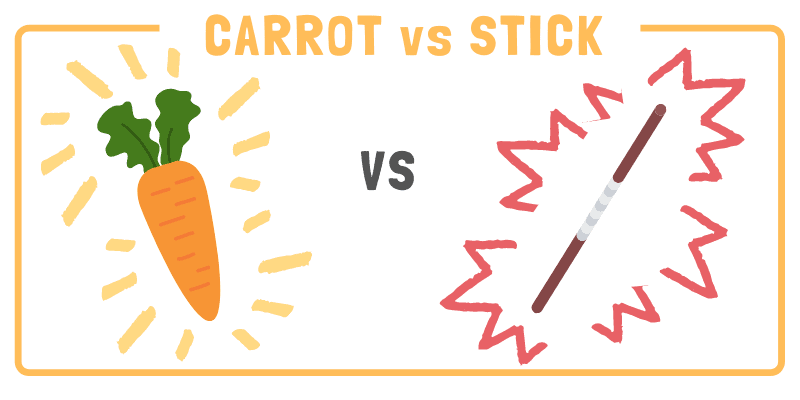
With positive reinforcement training, what’s driving your dog’s behavior is cookies. But for aversive training, what’s driving your dog’s behavior is fear and pain. I’d much rather be a treat slinger to my dog than use bullying intimidation tactics to make him afraid of me.
Also keep in mind that there needs to be continued reinforcement when training with aversives too.
Most dogs who learn not to pull to avoid pain while using a prong collar will begin pulling again once they realize they are not on a prong collar.
Most dogs who learn not to bark because they are shocked with a bark collar will begin barking again when the collar is removed.
No behavior your dog learns will be one and done. Every behavior needs intermittent reinforcement to be maintained.
If you learned how to play the piano in high school but didn’t touch a piano for 10 years, chances are you won’t be playing Mozart the first time you do practice again.
Using a Clicker in Positive Reinforcement Training
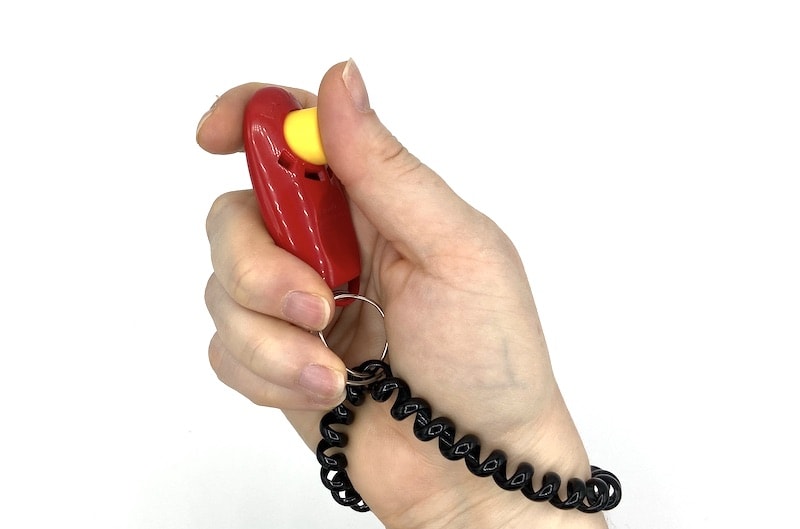
Clickers are small mechanical noise makers that emit a (wait for it…) clicking sound when pressed.
They are often considered a staple in positive reinforcement training, but they are by no means required – plenty of owners choose to use a marker word like “yes” instead of a clicker.
First Things First: You Have to “Charge” a Clicker
When clicker training a dog, the first step is to always “charge” the clicker.
Charging the clicker refers to creating an association between the clicker and a treat. To start charging a clicker, you will simply click the clicker and then give your dog a treat, several times in a row.
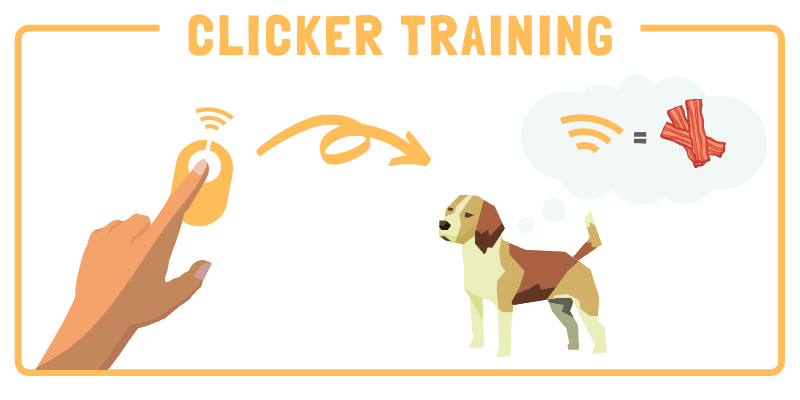
Soon, your dog will hear the clicker and expect a treat.
Once your dog has established the connection that click = treat, the clicker becomes a confirmation to the dog that he has performed the correct behavior and that his reward is on the way. This gives you a bit more time to physically get the treat out and dispense it to your dog.
Using a clicker allows you to be incredibly precise with training, and reward your dog the exact moment his butt hits the ground when teaching a “sit”.
However, even once your dog hears the click and associates it with a job well done, it’s essential to always back up the click with an actual treat. Otherwise, the clicker will lose much of its power and influence.
You can think about the click from a clicker a bit like when a child gets a ticket from an arcade. The ticket itself isn’t interesting, but the child knows that they can redeem the ticket for a prize. Because of this association, getting a ticket out of an arcade machine is very exciting!
But, if one day the ticket was brought to the counter and the arcade vendor refused to exchange it for candy or a toy, the ticket would lose all value. The next time a game spit out a ticket, the child wouldn’t be as excited since he or she would no longer know for sure if it could be exchanged for a prize.
Don’t Want to Use a Clicker? No Problem – Marker Words Work Too!
Some owners choose to use a marker word instead of a clicker. A marker word is a short, quick phrase to tell the dog they’ve performed the desired behavior. Common marker words include “Yes,” “Right,” “Got it.”
Avoid common, often used phrases like “Good dog” or “OK” for a marker word. These words are too commonly used to be special or unique enough for your dog to associate with a treat.
Using a word like “Good dog” as a marker word means that every time your pup hears someone say “Good dog,” he’ll expect a treat!
Now imagine when you go to the park and strangers approach your dog, telling him he’s a good dog. He is expecting a treat since you’ve been using that as a marker word, but he doesn’t get diddly squat!
Well, next time you do a training session and use the “Good dog” marker word, he won’t be as confident in the association since he knows now that he doesn’t always get a treat.
Being precise and exact is critical with positive reinforcement training!
Clicker-Training Provides Consistency
Another benefit of using a clicker is the consistency it provides.
Since a clicker sounds the same no matter who is using it, it’s easy for dogs to transition their training from one individual to the next. Marker words may vary in intonation and tone depending on who is performing the training, possibly adding confusion for the animal.
Other Things to Keep in Mind With Positive Reinforcement Training
Now that we’ve explained the basics of R+ training, we need to outline a few other things you’ll need to be mindful of when adopting this approach.
Shaping Your Dog’s Behavior: Sometimes, “Close Enough” Counts!
One powerful aspect of positive reinforcement training is shaping behavior. Shaping refers to rewarding approximations of the behavior you are looking for, even if your dog isn’t quite 100% there.
In other words, your dog doesn’t need to nail a given behavior to earn his reward and make progress — you can reward him for getting close. Then, with repetition and practice, he’ll slowly learn to get the behavior perfect.
Proper Reward Placement Is Important
Just as timing is essential for good training, proper treat placement is vital too. Small dogs shouldn’t have to jump up to get a treat after performing a solid “sit” – otherwise, you’re rewarding him for jumping!
The same holds true for teaching a “go to your bed” command. You’ll need to give your dog treats on his bed, even if that means walking across the room from where you are cooking in the kitchen to reward his continued stay.
Mastering a good, accurate treat toss can also be helpful. Finally those years of high school softball can come in handy!
Limit the Distractions & Choose Quiet Environments
For all training, it’s best to start out indoors, where distractions are limited. Keep in mind that your dog may nail a behavior or command indoors, only to struggle when you move outdoors.
The outside world provides ample distractions for your dog, and it can be very difficult for him to stay focused on you.
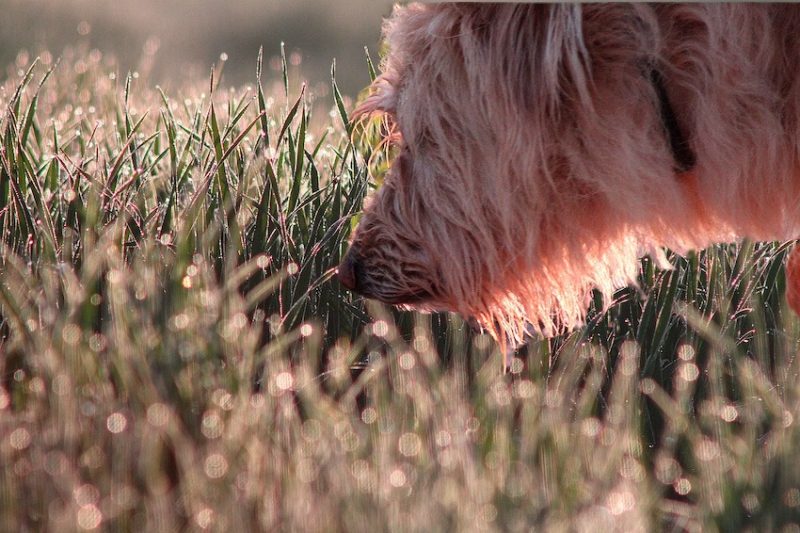
Expect to increase the value of the rewards as well as the frequency with which you dole them out when training in stimulating outdoor environments.
Have You Been Accidentally Reinforcing Unwanted Behaviors?
Once you learn the power of positive reinforcement, you may also begin to realize some of the ways you are inadvertently rewarding your dog for unwanted behavior. Effectively, you may have been reinforcing these undesired behaviors by mistake!
Common examples of unintended reinforcement include:
- Letting your dog outside when he pesters the cat. You may be putting your dog outside to give your cat a breather, but now your dog is learning that when he bothers the cat, he gets to go have fun outside! Instead, try gating your dog in a separate room, which isn’t fun for your dog and still gives your cat space.
- Petting your dog when he jumps up on you. We’re always excited to come home to our doggos, but petting and interacting with our dogs when they jump up in excitement is rewarding their jumping behavior. Even yelling “Get DOWN!” is rewarding to the dog who wants attention from you.
- Yelling at your dog for barking at people outside. We may think we are punishing a dog for barking by yelling at them, but in his mind, he is getting attention and interaction from you, which he loves!
You may suddenly discover that you are accidentally rewarding unwanted behaviors in a myriad of ways. Be more careful about how you interact with your dog and work on rewarding more desired behaviors to limit your dog’s naughty tendencies.
Operant Conditioning and the Science of Positive Reinforcement
To really understand positive reinforcement training, we have to talk a bit about learning theory. This applies to humans as well as dogs and other animals!
To start, we need to understand a type of learning called “operant conditioning.”
Operant conditioning is a type of learning in which a behavior increases or decreases based on the behavior’s consequences (such as reward or punishment).
Operant conditioning is made of four quadrants:
- Positive Reinforcement
- Negative Reinforcement
- Positive Punishment
- Negative Punishment
It’s really easy to look at these terms and assume meaning based on the connotations of “positive” as good and “negative” as bad, but in reality, it’s best to think about these types of learning in a mathematical sense.
POSITIVE reinforcement means you are ADDING a reward to INCREASE the behavior
POSITIVE punishment means you are ADDING an unenjoyable consequence to DECREASE a behavior
NEGATIVE reinforcement means you are REMOVING a painful thing to INCREASE the desired behavior
NEGATIVE punishment means you are REMOVING an enjoyable item to DECREASE a behavior
Let’s look at some real examples of how these training methods might play out:
Examples of Positive Reinforcement in Dog Training
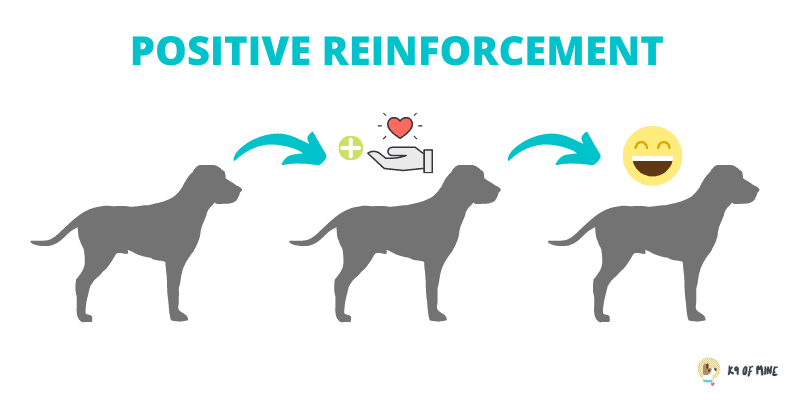
Something is added (+) to reward and reinforce a desired behavior.
Example: Your dog sits, so you give him a treat.
Your dog performed the desired behavior (sitting), and something was added (the treat). Your dog learns that when he sits, good things happen, so he’ll be sure to sit more often, reinforcing the behavior.
Examples of Positive Punishment in Dog Training
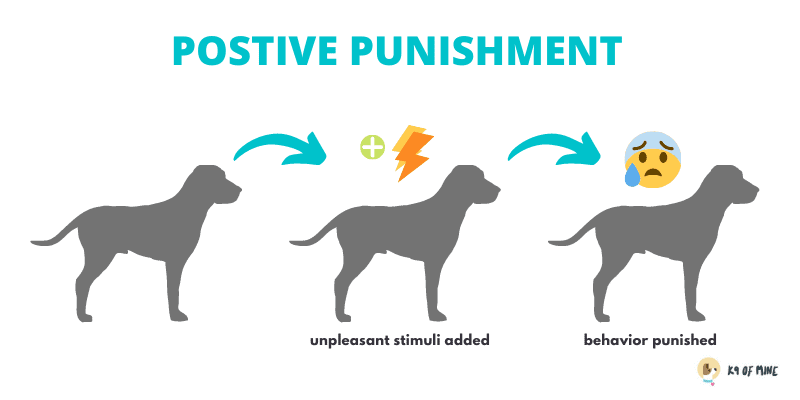
An undesirable sensation is added (+) to your dog to punish him, making the behavior decrease.
Example: Your dog barks at someone walking by your house outside, and you zap him with a shock collar. Your dog performed an undesired behavior (barking) and something was added (the zap). Your dog has learned that when he barks, something unpleasant happened. Now he will be less likely to bark at something outside in the future, decreasing the barking behavior.
Examples of Negative Reinforcement in Dog Training
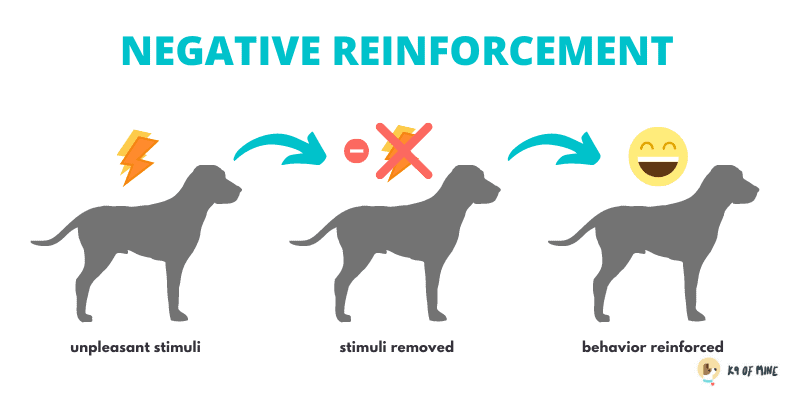
With negative reinforcement, an unpleasant sensation is removed (-) as a reward when a dog performs a desired behavior, reinforcing the behavior.
Example: Your dog has gone past the fence boundary while wearing a boundary collar and is being shocked. The unpleasant shocking sensation is removed once your dog returns to the yard boundary, rewarding him for returning to the yard.
Examples of Negative Punishment in Dog Training
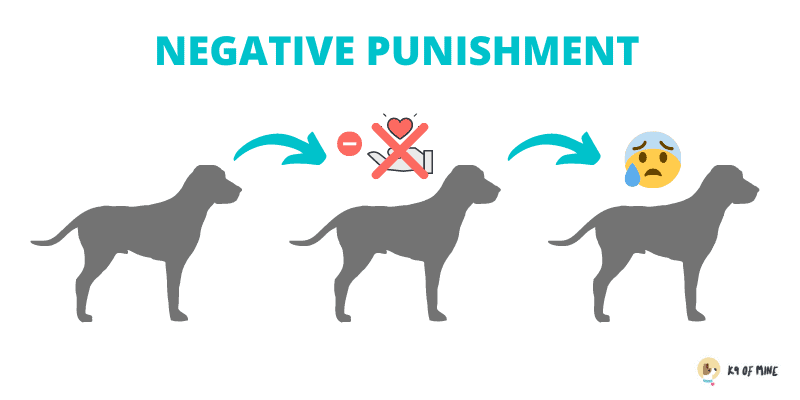
With negative punishment, a desirable object is removed (-) in order to decrease the unwanted behavior.
Example: Ending play and leaving the room when your dog is too rough with you during play. His behavior (being too mouthy during play) has made something good and desirable (your attention) go away.
Most positive-based trainers will incorporate negative punishment into their training, since it’s a milder form of punishment than positive punishment.
Positive Reinforcement Training vs Aversive Training
Modern, educated trainers prefer positive reinforcement training because it has a high rate of success and builds on a positive relationship with your dog.
Most positive reinforcement trainers rely primarily on positive reinforcement, along with some light negative punishment (but no positive punishment).
Let’s talk more about why positive punishment (adding something unpleasant to reduce a behavior) is so dangerous.
The Problem with Aversive Training: The Danger of Pain as a Motivator
Pain can be a powerful motivator, but in the long term, pain is not the most effective way to teach an individual. It also comes with a lot of negative repercussions.
It can be helpful to think about these concepts in terms of human learning as well.
Consider a classroom where a student is punished for an incorrect answer. This would be considered positive punishment. Embarrassment is added (+) to the student to make the behavior (answering incorrectly) decrease.
The problem is, in this situation, you aren’t just decreasing the likelihood of a student answering incorrectly – you’re also decreasing the likelihood of the student even trying to answer the question.
Why? Because the student is afraid to answer the question.
There is a chance if he answers the question, he will get it wrong. If he never tries to answer the question, he can avoid any chance of punishment.
This happens to dogs too! It’s referred to as learned helplessness, and it’s when dogs will shut down and become less likely to perform any behavior in case it results in punishment.

The negative consequences go further though.
When this student is punished for answering a question incorrectly, he may begin to associate negative emotions with the teacher, or even school in general. Over time, if this positive punishment is repeated, he may decide he hates learning and wants nothing to do with school. What a shame!
In your dog’s case, the use of pain (or other positive punishments) may cause him to fear you and training in general.
Positive Punishment is Dangerous Because Dogs Respond Poorly to Fear
The other issue with using positive punishment and aversives that capitalize on fear and pain to manage dog behavior is that dogs often respond to fear through increased aggression.
Fans of aversive methods will boast that, with their tools and techniques, dogs can be cured of even the worst behaviors in just a few minutes.
This is true to some degree; undesirable behaviors can seem to vanish through the use of aversives. But, just like painting a broken-down car, the car may look to be in good shape while big problems lurk under the hood.
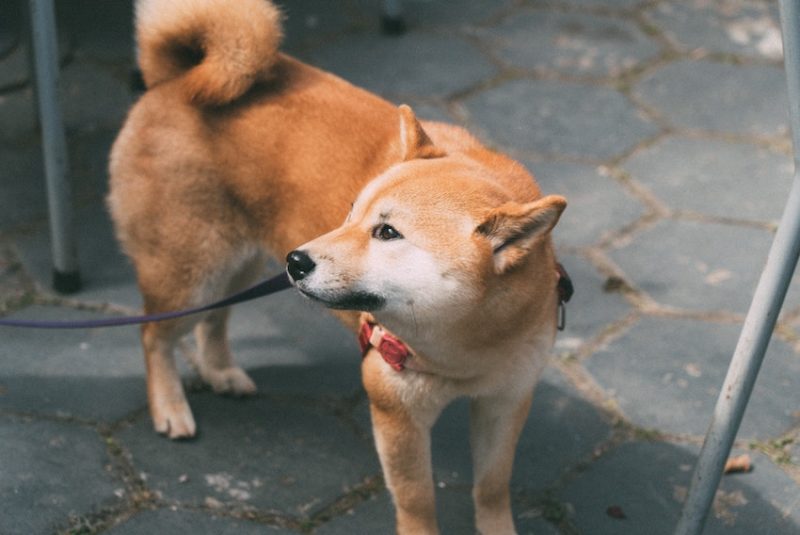
Using aversives can result in quick results because what they are actually achieving is behavior suppression. Behavior suppression does mean that your dog will stop performing the unwanted behavior, but only out of fear – not because you’ve helped him adjust or adapt.
You’re only fixing the symptom – not the root cause of the issue.
Behavior is driven by emotions, so if we’re not addressing the emotions behind our dog’s negative behavior, we aren’t really solving the problem at all. Instead, we’re simply avoiding it!
Leash reactivity is a great example of this in practice.
Some dogs will bark and lunge at other dogs while on leash. They most often perform this behavior out of fear.
Less knowledgeable trainers may suggest using a prong collar to prevent the reactivity, and this can have fast results. The dog will no longer bark and lunge at another dog because – when he does, he experiences pain from the collar.
Problem solved, and your dog isn’t reactive anymore! Right?
Wrong!
It’s helpful ask yourself: what is your dog learning in this situation?
Your dog is learning that when he barks and lunges at another dog, pain happens. But just as with our student answering an incorrect question, the dog’s learning is not being isolated simply to the lunging and barking action.
Instead, your dog is learning to associate other dogs with pain. Which, in turn, can make your dog even more afraid than he was prior to training.
Because aversives work through suppression, some owners may go through many years with their dogs adequately choking down fear and anxiety in order to avoid punishment. But behavior suppression always reaches a breaking point eventually. And when that breaking point comes, the dog “snaps.”
This is often where you hear of dogs becoming violently aggressive “out of nowhere.”
In reality, the behavior is not coming out of nowhere. The dog has likely been displaying body language signs of discomfort and anxiety for a long time, but since many owners are unfamiliar with these cues, they go ignored.
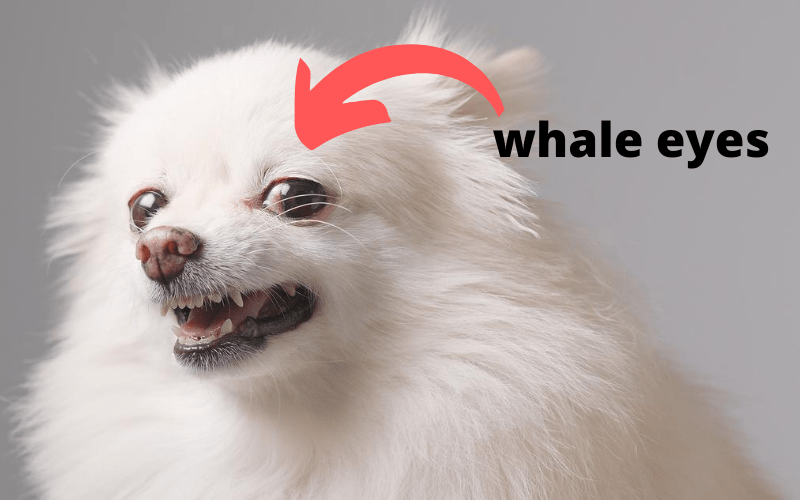
The dog has been punished for expressing fear through lunging, barking, or growling, so he doesn’t issue those warnings either.
Instead, he tampers down his feelings as long as he can, until the cork pops out of the bottle with a bite.
Sadly, it’s always the dogs who are punished by our lack of communication and guidance!
Let’s go back to the example of a reactive dog on leash (in part because this is something I’ve been working on with my own dog for quite some time now).
If we don’t want to simply suppress the barking and lunging behavior, what is the alternative?
The alternative is changing the dog’s emotional response to the stimuli. Instead of your dog associating the other dog on leash with fear, we want him to associate the presence of the other dog with good things.
This means dispensing treats to a reactive dog upon seeing another dog on leash.
Reactivity training can be a bit of an art, because you only want to give your dog treats for looking at the other dog when they are not barking or lunging.
In order to achieve this, you need to work under your dog’s threshold — the point at which he can still respond and listen to you without losing his cool.
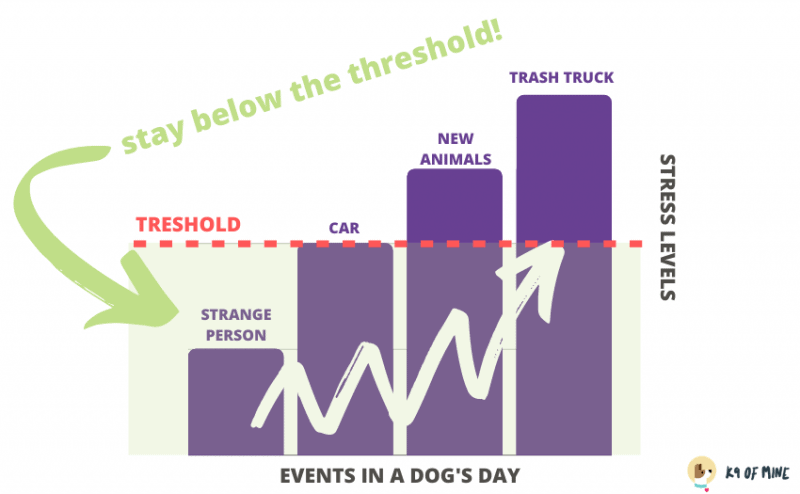
This often requires getting more distance from the other dog, and treating him when he observes the other dog from a safe distance while still being under his threshold and displaying relatively calm behavior (aka not acting like a lunging, barking mess).
Old Training Methods Vs Modern Training
Humans have come a long way in understanding dogs better in the past few decades.
Previously, dogs were viewed much more as functional tools than beloved family members. Dogs needed to meet a strict standard of behavior expectations in order to earn their place on the farm. Hunting dogs needed to track, herding dogs needed to herd. And they needed to do so reliably.
Strict, harsh training methods were the norm for ensuring that dogs performed the behaviors that we demanded of them quickly and efficiently. And if dogs couldn’t acclimate, they were put down without hesitation.
When dogs are considered tools, there are no concerns about the dogs emotional state. We don’t consider if our coffee cup is sad when it’s left dirty in the sink all day, and we don’t wonder if our couch misses us when we are away.
Historically, we treated dogs with similar disregard. We only cared that they performed the behaviors we desired.

Today, our culture values communication much more than it did previously. We have learned so much more about how dogs communicate and have gained a better understanding of the rich inner workings of their mind.
As it turns out, dogs are not so different than us. At least, not when it comes to learning.
Up until fairly recently, trainers didn’t concern themselves with anything other than punishment (corrections) and praise (reinforcement). Serious dog sport competitors used choke chains, and were frequently yanked all over.
For many years this was how service and police dogs were trained too. But to have successful outcomes with this training required a particular type of dog – the rare dog that could be bullied into submission without becoming too “soft” or completely breaking down.
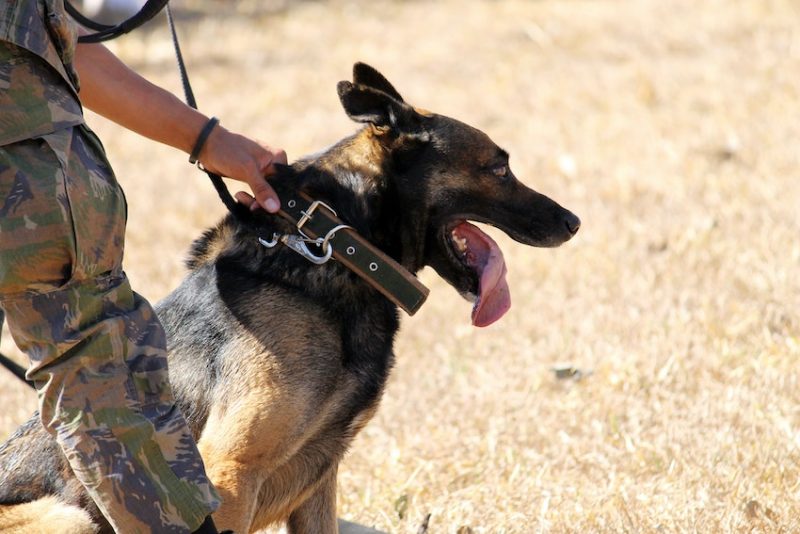
And, notably, one of the big issues with this training was the sheer number of dogs who couldn’t withstand these kinds of harsh training methods.
As noted by Karen Pryor:
Until recently, a serious cost factor in the training of guide dogs, patrol dogs, and other working dogs has been the flunk-out rate, the percentage of dogs that “shut down,” or “just don’t work out,” and have to be sold or given away as pets despite months or years of investment of time and money
Karen Pryor
Increasingly, more service animals and police dogs are being trained with positive reinforcement after trainers witnessed the great success it yields with no negative repercussions.
When we train our dogs with compassion and empathy, we get a win/win situation. We get happy dogs who are well-adjusted and have learned to thrive in our world of human rules while still maintaining their individual spirit.
With aversive-based training and debunked dominance/alpha training, the end result is fearful, anxious dogs who have learned not to fully trust their humans.
The best-case scenario is learned helplessness, and the worst case is a bite that happens one day “out of nowhere.”
Positive Reinforcement Is Difficult Because It Requires Empathy
Positive reinforcement based training has so many detractors for one simple reason: It’s not easy.
Positive reinforcement training requires listening to your dog and learning how to recognize his communication signals. It requires a lot of empathy and understanding.
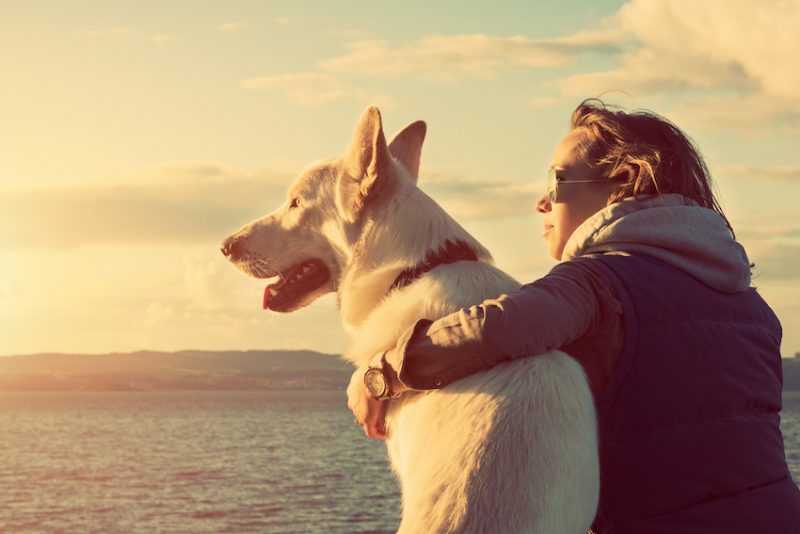
It takes a lot of mental energy to truly consider how your dog experiences the world, which is dramatically different than our human experience!
It also takes tremendous patience, as positive reinforcement works towards real, authentic behavior change, and that doesn’t happen overnight.
Real change happens slowly. Much more slowly than we’d like.
Positive reinforcement-based training requires much more time and commitment than traditional aversive training. But the results are rewarding enough to make all the work worthwhile.
Not only will you be changing your dog’s mindset, but you’ll also strengthen your bond in a way you never could through punishment.
For me personally, witnessing the change in my own dog felt a bit like a mini miracle, and it inspired me to take note of the change I want to implement in my own life.
Improvements Are Subtle with R+ Training: Change Takes Time
Change is slow. So slow, that it’s very easy to miss.
Imagine you were asked to study a small plant for five minutes each day, photographing and documenting what you saw.
Each day, a professor might come to you and ask what progress you saw the plant make. When flipping between that day’s notes with the current photograph of the plant and the previously day’s notes and photograph, you would say nothing had changed at all.
But, after a month, if you looked back to your first plant photograph and notes, you would no doubt recognize that – actually – a lot has changed.

Dog training can be a bit like that sometimes.
It feels like change happens so slowly, you may wonder if it’s happening at all. Some days your training takes one step forward and two steps back.
But after one month, three months, or six months, if you truly consider where you were at the start of your training, you’ll be amazed at how far you and your doggo have come.
Change is like that for all of us. There are no shortcuts or easy answers. There are no magic elixirs. Only hard work. But that hard work is always rewarded.
Positive Reinforcement Troubleshooting: Why Is It Not Working?
Feel like positive training isn’t working for you? Here are some common areas where owners fail:
- You’re not using desirable enough rewards. The most common mistake owners encounter with positive reinforcement training is not sufficiently addressing motivation. Kibble won’t cut it with R+ training, especially when you’re battling against ingrained behaviors that are self-rewarding for the dog (like nuisance barking, chewing, etc).
- You aren’t delivering rewards quickly enough. If you’re giving your dog a treat for sitting after he’s already gotten up and approached you, you’re too late! Try using a clicker or simply carry a treat bag (or just stuff ‘em in your pocket) so that you can dispense treats more quickly and at the correct time.
- You need to practice more. Your dog won’t continue to perform a desired behavior simply because he was rewarded once – you have to reinforce your training over and over again before it’ll truly sink in for your dog.
- You’re working around too many distractions. Many owners will label their dog as “stubborn” when they won’t respond to a recall command (like “come”) outside. But in reality, it is much more difficult for a dog to focus outside – which is full of amazing sights, sounds, and smells – than inside his home where he spends most of his day.
Asking your dog to follow your commands at a park is a bit like asking a child to sit down and take an algebra quiz at Disneyland. It’s going to be awfully difficult!
Instead, always start training indoors, then move to a familiar area outside (like a back yard) before even attempting commands in a new environment.
Positive Reinforcement FAQs
Even though positive reinforcement techniques are gaining popularity, the entire R+ training style sparks a lot of questions among owners. We’ll try to answer a few of the most common ones below.
What if my dog isn’t food motivated?
Some owners find that food isn’t as desirable a reward as a game of tug or fetch. But the truth is that 99% of dogs are indeed VERY food motivated – you just might not be using a very desirable food!
Keep in mind the boring kibble your dog gets every day for food isn’t very enticing for training. Instead, try something special and stinky – the meatier the better!
If you think your dog isn’t food motivated, try using hot dog slices, string cheese pieces, or chunks of rotisserie chicken, and I think you’ll find your dog is plenty motivated by the right kind of food.
Don’t different dogs need different learning styles?
While it’s true that different dogs may be more motivated by certain rewards than others (such as a game of fetch vs a treat), all dogs learn best through positive reinforcement and by avoiding positive punishment.
A lot of “balanced” trainers (aka trained who use aversives like shock collars and prong collars) will say that different dogs learn differently. They might say your dog is too stubborn for positive reinforcement training. This is largely an excuse to use aversives, which can have faster, easier outward results, but cause significant psychological damage.
There are no risks to using positive reinforcement training, but there are big potential risks to using aversives like shock collars. Numerous experiments — such as this 2017 study, published in Journal of Veterinary Behavior Clinical Applications and Research
— have shown that dogs trained with punitive methods often exhibit problem behaviors, including fear and aggression.
Other studies, like this 2020 pre-print, have also shown that dogs trained with aversives experience more stress and show higher cortisol levels after training than dogs trained through positive reinforcement.
On top of the scientific research, many animal welfare and animal behavior organizations, such as (e.g., American Veterinary Society of Animal Behavior and the Association of Professional Dog Trainers have published statements denouncing the use of aversive training methods that inflict pain (including shock collars, choke chains, and prong collars, among others), and several countries including Denmark, Germany, and Finland have actually banned the use of such collars because of the potential for physical injury to the dogs
Positive reinforcement is the safest and most effective training option, regardless of the issue.
Do I have to use a clicker?
Not if you don’t want to!
Clickers are favored by many owners and trainers due to their exactness and consistency. We’d suggest giving clicker training a chance – it can certainly feel awkward and cumbersome at first, but with a little practice you may begin to find clicking as natural as breathing!
However, if you really can’t stand the clicker, you can always use a marker word like “Yes!” Make sure you use a marker word that isn’t already used regularly – the word should be fairly unique and not accidentally spoken often.
This is why “good dog” isn’t a great marker-word; we’ll often shower our doggos with praise and acclimations of “Good boy” without dispensing a treat. This out-of-context use of the marker word can ruin its effectiveness.
Also make sure you are using the same tone and intonation for your marker word. Consistency is really important!
Do positive-based trainers ever tell a dog “no?”
This is a common misconception about positive reinforcement-based trainers!
The vast majority of R+ trainers have no issue with delivering a verbal interrupter like “No,” so long as the trainer is also redirecting the dog to a different, more appropriate behavior and rewarding the dog as a result.
While issuing a verbal interrupter isn’t damaging to your dog, it’s not particularly helpful either because you aren’t telling your dog what he should be doing instead! The goal is to guide your dog into making the right choices and reinforcing those good decisions!
***
Our culture has very much glorified dogs to an unrealistic status. Dogs are not animals born to cater to our every whim and function as puddles of affection 24/7.
They are individuals with their own motivations and desires. It’s YOUR job to motivate your dog, and the best form of motivation and training will be positive reinforcement-based!
As you can see, there are a ton of benefits to positive reinforcement training. Your dog will certainly love this training style and likely start picking up lessons and skills more quickly, but you’ll likely find that you enjoy this training style more too!
Do you use positive training methods to teach your dog skills? What kinds of things do you like about this approach?
Have you noticed that your dog seems to enjoy training sessions more? Let us know your experiences — as well as any questions you may have — in the comments below!
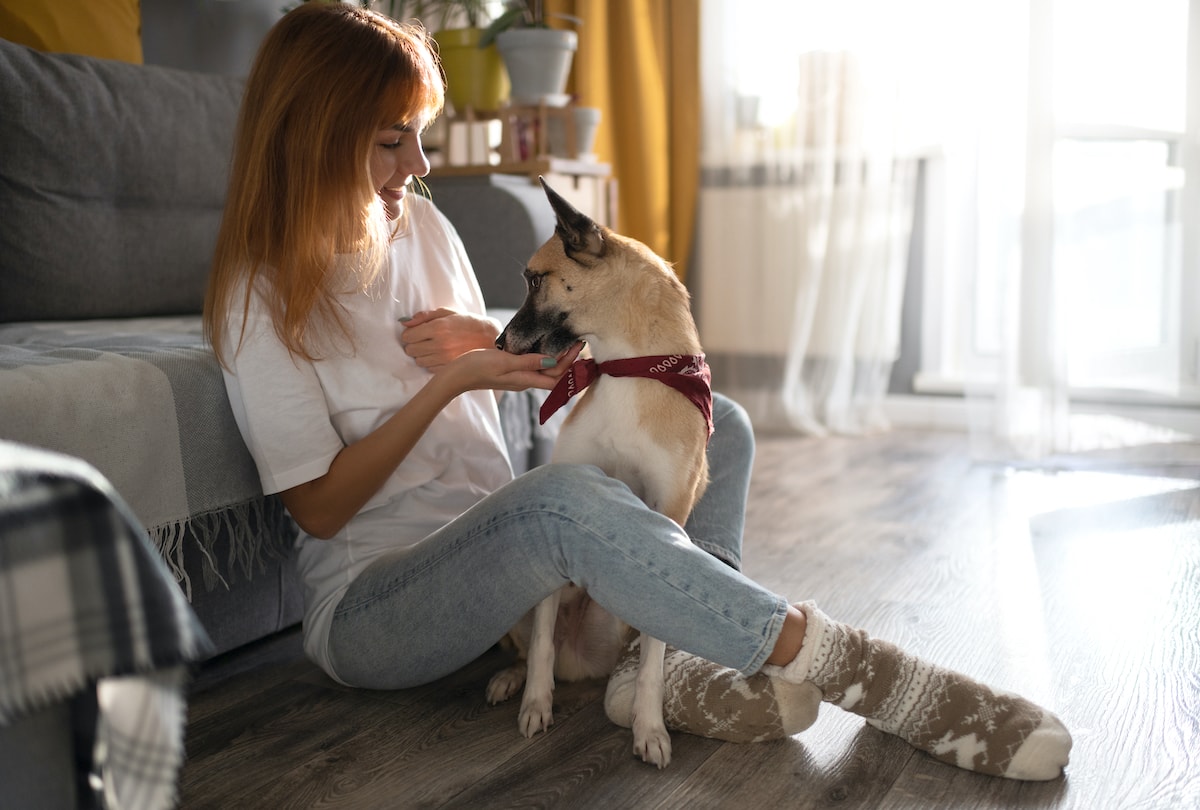

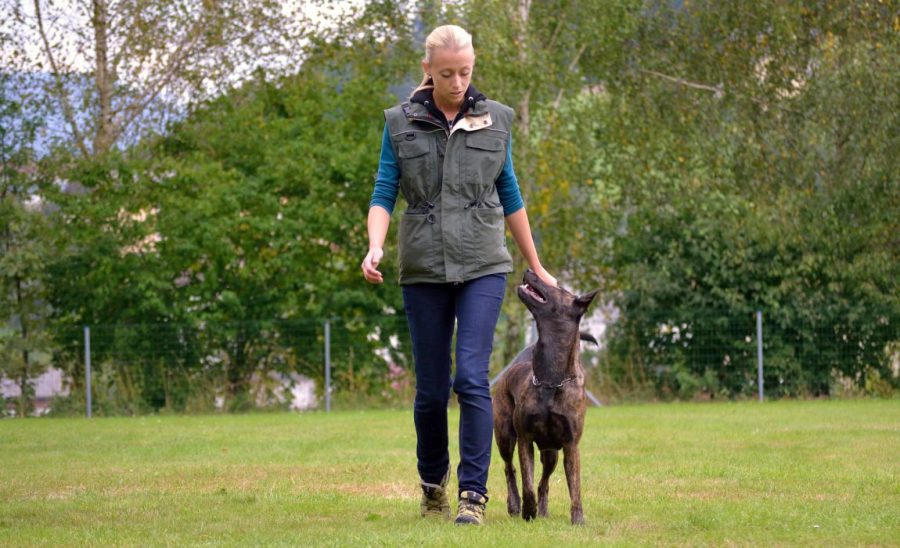


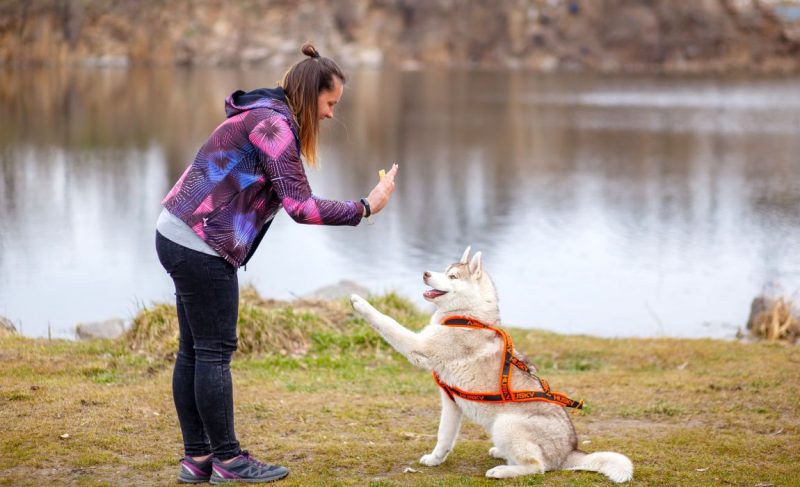
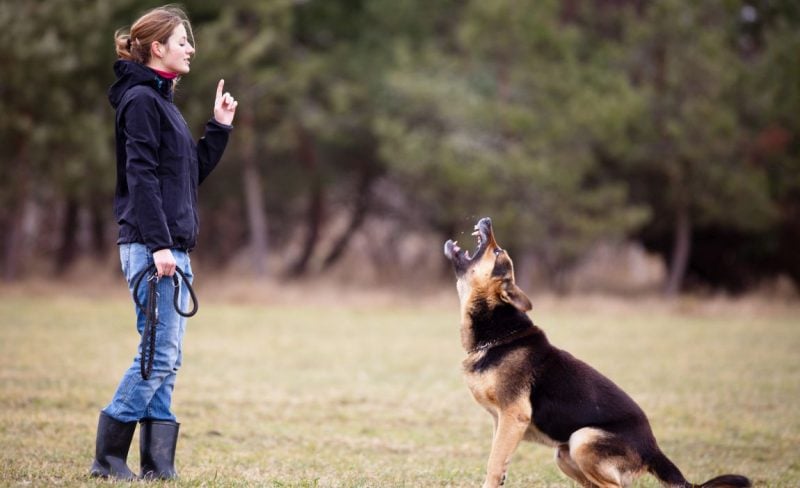
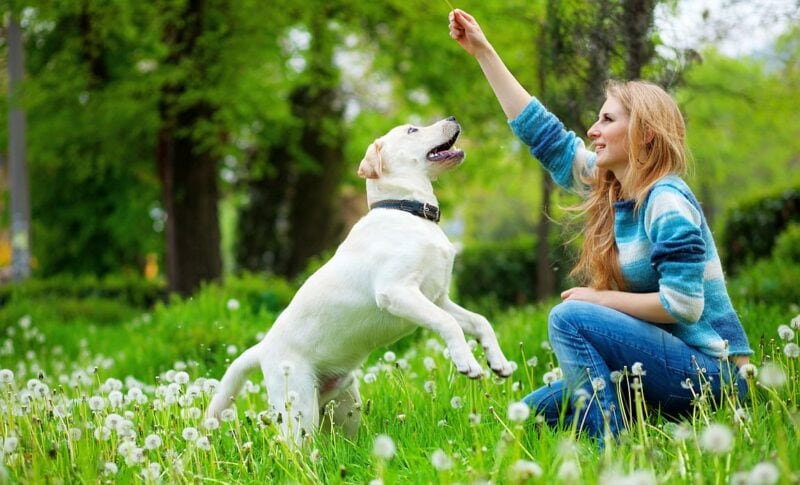
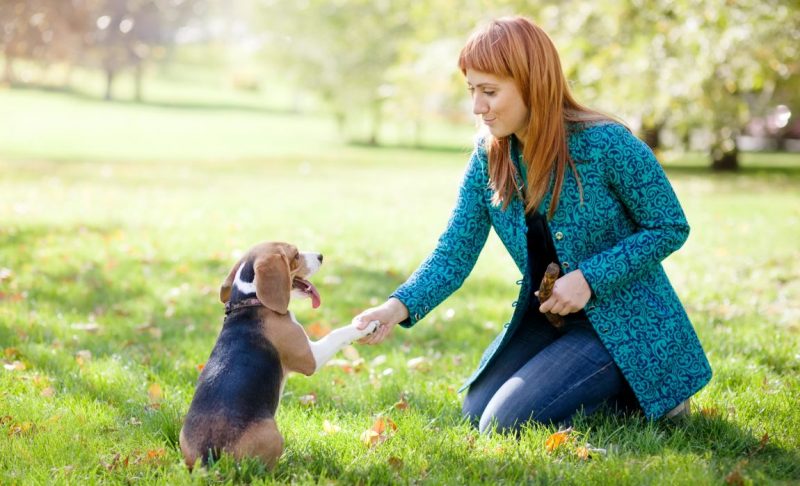
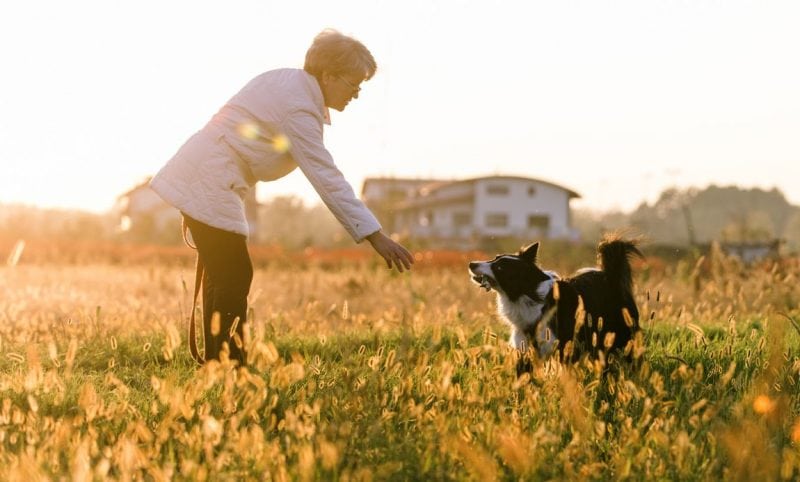

Leave a Comment